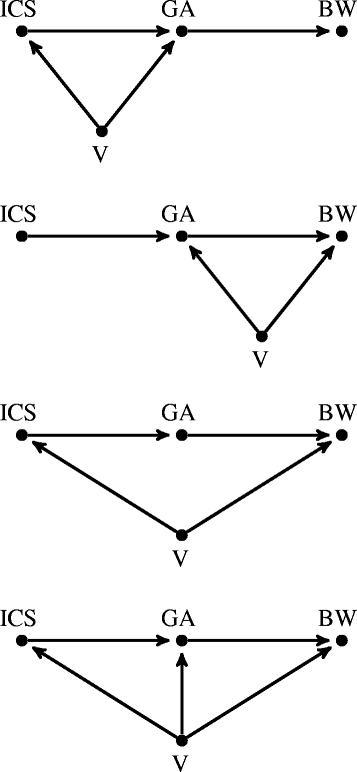On the use of the outcome variable "small for gestational age" when gestational age is a potential mediator: a maternal asthma perspective
- PMID: 29228913
- PMCID: PMC5725795
- DOI: 10.1186/s12874-017-0444-z
On the use of the outcome variable "small for gestational age" when gestational age is a potential mediator: a maternal asthma perspective
Erratum in
-
Correction to: On the use of the outcome variable "small for gestational age" when gestational age is a potential mediator: a maternal asthma perspective.BMC Med Res Methodol. 2018 Jan 29;18(1):17. doi: 10.1186/s12874-018-0477-y. BMC Med Res Methodol. 2018. PMID: 29378519 Free PMC article.
Abstract
Background: The variable "small for gestational age," frequently defined as birth weight below the 10th percentile in a gestational age and sex-normalized population, is nowadays generally perceived as a more adequate measure than birth weight or low birth weight (birth weight < 2500 g) to capture fetal growth. However, the use of small for gestational age rather than birth weight or low birth weight as an outcome (dependent) variable may have important impacts on the interpretation of analyses aimed at estimating the causal effect of an exposure of interest on infants. We hypothesized potential differences in both types of effects estimated (direct or total) and in ability to control for confounding bias.
Methods: We first examined the use of outcome variables birth weight and small for gestational age to get insights on modeling practices within the field of maternal asthma. Using directed acyclic graph simulations where gestational age was a potential mediator, we then compared estimated exposure effects in regression models for birth weight, low birth weight, and small for gestational age. Graphs with and without confounding were considered.
Results: Our simulations showed that the variable small for gestational age captures the direct effect of exposure on birth weight, but not the indirect effect of exposure on birth weight through gestational age. Interestingly, exposure effect estimates from small for gestational age models were found unbiased whenever exposure effect estimates from birth weight models were affected by collider bias due to conditioning on gestational age in the models.
Conclusions: The sole consideration of the outcome small for gestational age in a study may lead to suboptimal understanding and quantification of the underlying effect of an exposure on birth weight-related measures. Instead, our results suggest that both outcome variables (low) birth weight and small for gestational age should minimally be considered in studies investigating perinatal outcomes.
Conflict of interest statement
Ethics approval and consent to participate
Not applicable.
Consent for publication
Not applicable.
Competing interests
The authors declare that they have no competing interests.
Publisher’s Note
Springer Nature remains neutral with regard to jurisdictional claims in published maps and institutional affiliations.
Figures


References
MeSH terms
Substances
LinkOut - more resources
Full Text Sources
Other Literature Sources
Medical

